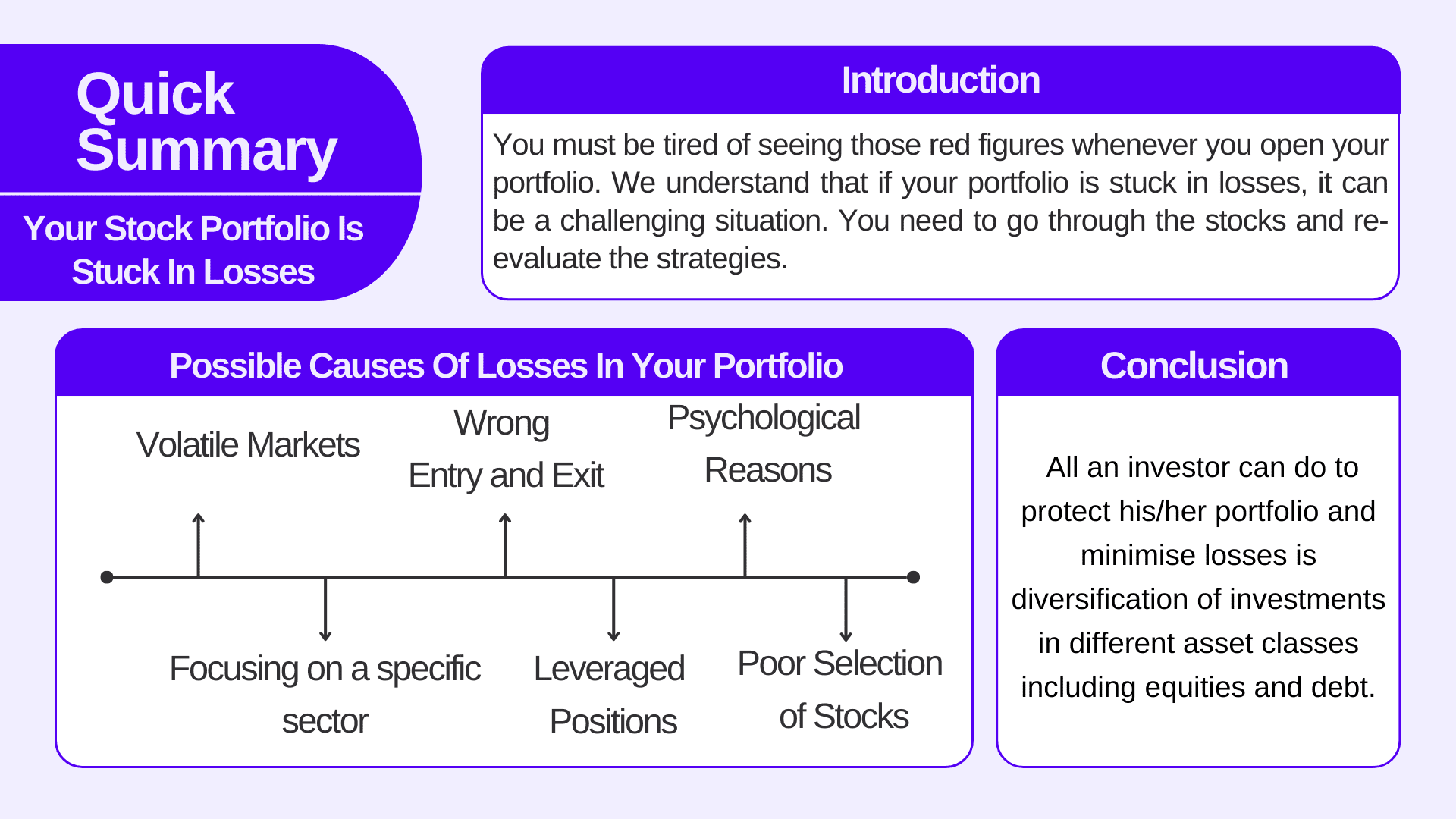| Type | Description | Contributor | Date |
|---|---|---|---|
| Post created | Pocketful Team | Nov-29-23 |

- Blog
- what should you do if your stock portfolio is stuck in losses
What should you do if your stock portfolio is stuck in losses?


You must be tired of seeing those red figures whenever you open your portfolio. We understand that if your portfolio is stuck in losses, it can be a challenging situation. You need to go through the stocks and re-evaluate the strategies. It is necessary to analyse your portfolio with a level-headed mindset and consider different factors before reaching any decision. You need not worry because we got you covered and in today’s blog, we will be exploring key steps to help you navigate the losses and work towards a more strategic approach.
Possible causes of losses in your portfolio

Below listed are some of the causes that can land you in losses.
- Volatile Markets
- Focusing on a specific sector
- Wrong Entry and Exit
- Leveraged Positions
- Psychological Reasons
- Poor Selection of Stocks
Let’s understand above mentioned reasons in depth:
Volatile Markets
Stock market fluctuations are normal and any sort of volatility in the short-term can lead to unrealised losses. Economic uncertainties like global economic conditions and geo-political events can contribute to volatility in the market. Therefore, if you are a short-term investor you need to be careful about the economic activities and global events.
Focus on a specific sector
Warren Buffet once said, “Do not keep all your eggs in one basket”. Hence, concentrating on one sector can expose your portfolio to sector-specific risks. Any kind of challenge in that particular sector can impact the performance of the stocks of that particular sector.
Wrong Entry and Exit
A lack of technical analysis and bad trading decisions can lead to poor timing of entry in the market. Buying stocks when they are at their highs can affect the overall performance of your portfolio.
Leveraged positions
If you do margin trading chances are likely that you will end up amplifying your losses because any kind of trend reversal in the market can worsen your situation and you will be forced to liquidate your portfolio at unfavourable prices.
Psychological Reasons
Herd mentalities won’t work when trading in the stock market. If you are someone who frequently invests or trades on tips and bets on random stocks you will lose all your capital because people can have different financial goals and risk appetite.
Poor selection of stocks
It is important to analyse any stock technically and fundamentally before investing. Without proper study, stock selection can be tough and can impact your portfolio.
Read Also: 10 Top Investors In India And Their Portfolios
How to deal with red portfolio

Let’s discuss the ways through which you can manage the losses and turn your portfolio into green.
Revaluation
Analyse the reason you initially invested in the losing stock. Are there any kind of fundamental changes since then? We say that candlestick charts are astrological graphs of any stock. Go through these charts and try to know the current trend of that stock. The initial reason for investment should still align with your long-term investment goals. If you find anything fishy then consider exiting the stock.
Long-term perspective
If you are a long-run investor and revisit your portfolio every now and then, it may lead to disappointments because those red figures might bother you. As company goes through several phases, it might be the case that your stock is in red now because of temporary reasons. If company’s philosophy is aligned and management is good then stocks often generate good returns to Investors but yes that takes patience. Since patience is the key to successful investing in the stock market you need to wait for the stock to recover from the losses.
Some wise person once said “Checking your portfolio daily is like putting up a web-cam in the forest to see if the trees are growing.”
Portfolio-review
Review your portfolio periodically say once every quarter and keep a check on your investment strategies. Consider rebalancing your portfolio quarterly, half-yearly or annually according to your current financial situation and market conditions.
Follow Stop-loss
Strict stop-loss is a prudent decision. Learn to respect the stop loss. If there is a sudden fall in the margin or ratios of the stock, consider selling and reallocating the funds. Stop loss is designed to limit an investor’s loss in a position. There is no point of staying investing in a stock that has underperformed over the years and is no longer giving you returns.
Invest practically and not emotionally.
Risk-Appetite
Reassess your risk tolerance. If the losses are causing significant stress or anxiety, it may be an indication that your risk tolerance needs adjustment. Your portfolio should match your comfort level and your goal of investments.
Diversification
Do not concentrate your investment amount on an individual stock or in stocks of the same sector. Diversify your portfolio in order to reduce stock specific and sector specific risks. This can help you in mitigating the losses because not all the stocks in your portfolio will give you losses.
Exit your mistakes in Bull Market
Go through the overall market trends including the global economy. Sometimes market gives golden opportunities to investors to exit their mistakes, as in Bull run, most of the stocks do well irrespective of their fundamentals.
“No stock in an uptrend has ever gone bankrupt.” – Walter Deemer
Advice from professionals and experience.
If you are a newbie, you must understand the fact that a journey in the stock market is a roller coaster ride. If you are not able to navigate your losses and diversify your portfolio, go for professional advice. An experienced person can give market insights and help you make investment decisions as per your risk and financial goals
Invest at regular intervals
One of the best ways to avoid losses and reduce the risk is regular investment. We have already discussed about selling the investments if they are not generating returns, but we also want to make you aware of the art of averaging the stocks. Falling markets give us losses and we all know this. But instead of panic selling, you can choose take benefit of downtrend and average the stock if it’s fundamentally strong.
Note: Averaging of stocks is defined as buying more shares of that stock over time to lower the average buy price of the stock provided the price of the share is trading below your initial buy price.
Conclusion

It is important to be mindful of your investments because there is no guaranteed technique to escape losses in the stock market. All an investor can do to protect his/her portfolio and minimise losses is diversification of investments in different asset classes including equities and debt. You should know that only an optimistic approach will work well with your developed strategies throughout your investment journey. The stock market inherently carries risk and it’s unavoidable. Any investor should make decisions based on his/her own rationale. You just need to be consistent and patient and the market will surely reward you with profits.
The decision is tough but will be worth it!
Frequently Asked Questions (FAQs)
If your portfolio is stuck in losses what should be the first step?
The first step should be analysing the reasons for the losses – It can be either stock specific (e.g. Yes Bank) or market specific (e.g. Covid-19). Force selling in a market specific scenario is not ideal.
Should an investor consider selling stock immediately once the portfolio turns red?
No, by doing so s/he will be selling the stocks in a panic state. Sit back and analyze the technical and fundamentals of the stock. Always take the decision with a clear mind.
How can diversification help you minimise your risk?
Diversifying your portfolio can help you in eliminating the stock specific or sector specific risks.
Can professional advice help you reduce losses?
Yes, professionals can help you making an informed decision.
How to control emotions when trading in the stock market?
When trading in the stock market you should be disciplined. Further, educate yourself so that you can make better investment decisions and formulate profitable strategies. Always remember that Emotional biases are easier to understand but difficult to overcome.
Disclaimer
The securities, funds, and strategies discussed in this blog are provided for informational purposes only. They do not represent endorsements or recommendations. Investors should conduct their own research and seek professional advice before making any investment decisions.